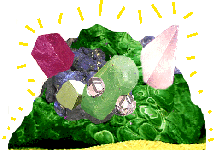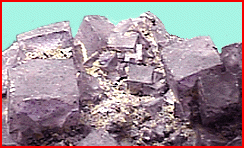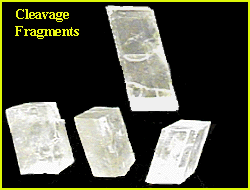 | "OK, Lou! It's crystal time!" |
|
|
 | "I like them, I like them!! But tell me, because I know you want to, what are they?!" |
|
 | "In most cases, minerals grow into irregular, random shapes! But under certain ideal circumstances, minerals grow so that they are bounded by flat faces to form regular geometric solids called crystals!" |
|
|
|
 | "Sounds like cleavage fragments! When I studied breakage, I learned that some minerals break into pieces that are cubes and rhombohedrons and other geometric shapes!" |
|
|
 | "Well, yes and no! Although crystals may resemble some types of cleavage fragments - the ones that are regular, geometric solids - they are not cleavage fragments because crystals are the result of growth, not breakage!" |
|
 | "But how can you tell crystals and cleavage fragments apart?" |
|
 | "Well, there are some crystal shapes that cleavage fragments are extremely unlikely to have!" |
|
|
|
 | "Wow!!! What's that cross!? Is it natural!!?" |
|
 | "It sure is! It's two crystals grown together in a symmetrical way! It's an example of a twin crystal! Nothing would break that way! And then there are other subtle features that can help you know that something grew rather than broke into the shape!" |
|
 | "Sounds complicated! Do you have names for the different shapes?" |
|
 | "It can be complicated! Some names are simple, like "cube" or "octahedron", but many names are long and complex. We won't bother with the names! And to tell the truth, Lou, it can often be tricky for the beginner to tell crystals and cleavage fragments apart! You won't be asked to do that!" |
|
 | "What will I be asked to do!?" |
|
 | "You need to concentrate on recognizing shapes! Assuming the specimens you'll be looking at are crystals, the shapes they have can help identify which minerals they are! For each mineral, certain shapes are possible and common - and other shapes are impossible or rare!" |
|
 | "I'd like to know how minerals grow and how they get those shapes!! And how to find them!!" |
|
 | "Good questions!! To find out more, visit  "Crystal City"! OK!! Now see if you can match ideal crystal shapes with the shapes of actual crystals!" "Crystal City"! OK!! Now see if you can match ideal crystal shapes with the shapes of actual crystals!" |
|






















 "Crystal City"! OK!! Now see if you can match ideal crystal shapes with the shapes of actual crystals!"
"Crystal City"! OK!! Now see if you can match ideal crystal shapes with the shapes of actual crystals!"